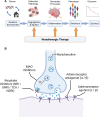Noradrenergic therapies in neurodegenerative disease: from symptomatic to disease modifying therapy?
- PMID: 40904583
- PMCID: PMC12402774
- DOI: 10.1093/braincomms/fcaf310
Noradrenergic therapies in neurodegenerative disease: from symptomatic to disease modifying therapy?
Abstract
A feature shared by many different neurodegenerative diseases is early pathology and degeneration of the pontine locus coeruleus. The human locus coeruleus contains about 50 000 neurons and is the primary source of the neurotransmitter noradrenaline. We propose the hypothesis that noradrenergic drugs can have broad, transdiagnostic benefit in slowing or preventing the progression of neurodegenerative diseases. There are direct noradrenergic anti-inflammatory effects in vivo, with microglia and astrocytes regulated by adrenoreceptors, and noradrenergic influences on glymphatics. Noradrenaline loss is associated with a pro-inflammatory state, promoting further neurodegeneration. Noradrenergic neuron loss is associated with worsening of both amyloid and tau deposition in animal models. There may be indirect survival benefits arising from alleviating the prognostically detrimental features of apathy and impulsivity, and noradrenergic influences on other neurotransmitters. The evidence base we set out supports the need for clinical trials of noradrenergic treatments for disease-modification.
Keywords: locus coeruleus; neurodegeneration; noradrenaline.
© The Author(s) 2025. Published by Oxford University Press on behalf of the Guarantors of Brain.
Conflict of interest statement
The authors report no competing interests.
Figures




References
-
- World Health Organization . Towards a dementia plan: A WHO guide. World Health Organization; 2018.
-
- Braak H, Thal DR, Ghebremedhin E, Del Tredici K. Stages of the pathologic process in Alzheimer disease: Age categories from 1 to 100 years. J Neuropathol Exp Neurol. 2011;70(11):960–969. - PubMed
-
- Mann DMA, Lincoln J, Yates PO, Stamp JE, Toper S. Changes in the monoamine containing neurones of the human CNS in senile dementia. Br J Psychiatry. 1980;136(6):533–541. - PubMed
Publication types
Grants and funding
LinkOut - more resources
Full Text Sources
